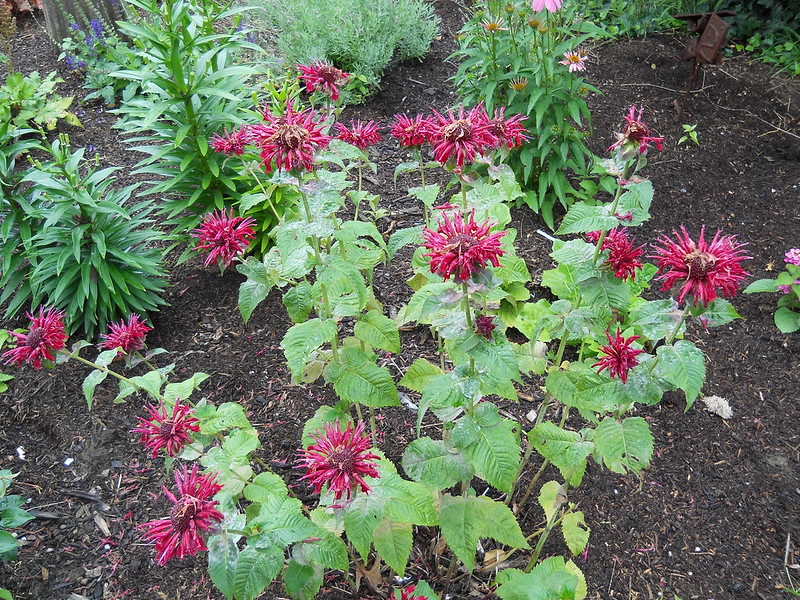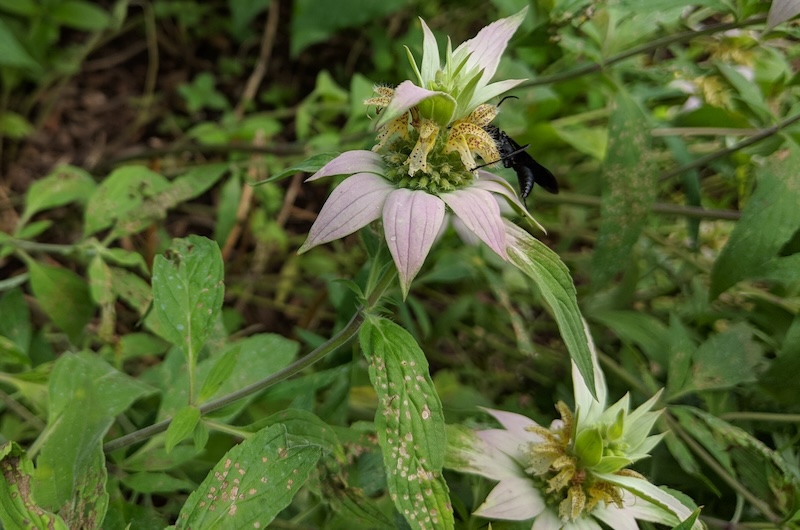The most common diseases to attack bee balm are all fungal and easily controlled using simple cultural methods. Powdery mildew, rust, and Southern blight strike bee balm when the air temperature and humidity levels are just right for them to survive. Southern blight and rust thrive in high humidity and warm temperatures, and tend to be more active from mid-summer to early fall, while powdery mildew favors cool nights and dry days.
The fungal spores are more likely to be spread from plant to plant by wind than by rainfall or overhead watering. The risk of these diseases can be dramatically reduced by choosing varieties and cultivars of bee balm that are proven to be disease resistant.

Photo by Dianna Ott, unmodified, Flickr, copyright CC BY 2.0 DEED
Powdery Mildew
Powdery mildew is scientifically known as Erysiphe cichoracearum. This disease is spread by fungal spores that land on the surface of the leaf and spread to the underside as the spores grow. Young growth may appear distorted and stunted, although the disease rarely permanently damages the plant. Powdery mildew is most active when nights are cool and days are warm and dry. While there are some plant-specific species of Erysiphe, many varieties are indiscriminate and will attack neighboring plants, causing large outbreaks in heavily planted garden beds or raised beds in a kitchen garden.
Identifying Powdery Mildew
The early stages of this fungal disease appear as powdery spots of white or pale yellow on the upper surface of the foliage. The spots will begin to grow together, eventually covering the whole surface of the leaf, which interferes with photosynthesis. Reduced photosynthesis leads to distorted and stunted new growth and a decline in plant flowering or seed production.
Treating Powdery Mildew
The first step to controlling powdery mildew is to check plants daily during when days are dry and nights are cool. This disease will appear and spread seemingly overnight. Remove any foliage with powdery markings and dispose of it in the trash. Do not compost any diseased plant material in a home composting system.
Spraying fungicides protects only unaffected parts of the plant and does not kill the disease. Plant varieties of bee balm that are specifically tagged to be resistant to disease, and always practice good garden hygiene at the end of the growing season. Remove spent top growth on infected plants and dispose of it in the trash or commercial composting containers.
Rust
Two different species of rust are most commonly found on bee balm: Puccina augustata and Puccina menthe. Both disfigure the plant without causing any serious harm. Warm and humid days are ideal conditions for rust spores to travel around the garden. The infection starts with yellow or orange spots appearing on the stems or foliage. Over time, the spots get larger and resemble streaks of rust. The infection impairs photosynthesis and will eventually slow growth.
The spores can overwinter in the soil and on any infected plant material left on the soil. Rust diseases are plant specific, but will travel between plants rapidly. Rusts also require primary and alternate host plants to spread, most often local weed species that harbor the fungal spores.
Identifying Rust
Small orange or rust-colored spots typically appear on the undersides of leaves. As the disease progresses, streaks of rust appear on the stems and flower buds.
Treating Rust
Regular inspection of plants during warm and humid weather will help to catch any infection early before it becomes unmanageable. Remove foliage that has the telltale rust spots and dispose of them in the trash or commercial compost bins. Remove spent top growth at the end of the growing season instead of letting the material decompose in place over the winter. Spores can overwinter in the soil or on foliage. Avoid overhead irrigation to keep spores from further spreading on the plant. If plants continue to become infected, consider growing varieties and cultivars that are specifically labeled as rust resistant.

Photo by Leonardo Dasilva, cropped, Flickr, copyright CC BY 2.0 DEED
Southern Blight
Southern blight, also known as Sclerotium rolfssi, is a fungal disease that strikes a wide variety of ornamental and edible plants. It lives in the top 1-2 inches of soil and is only active during periods of heat, rarely causing damage during the spring or fall. The blight kills portions of the plant seemingly overnight and can spread to the whole plant in a relatively short period.
The fruiting bodies of this fungus appear as small yellowish round pods, the size of mustard seeds. The pods remain on the surface of the soil, making their way into the crown and lower stems of bee balm. Southern blight rarely affects the roots, even though the top growth appears to be dying or dead.
Identifying Southern Blight
Infected plants may suddenly collapse or die back late in the growing season or after periods of high heat. Threads of white mycelium may be seen on the surface of the soil and at the base of the plant.
Treating Southern Blight
There is no treatment for plants infected with Southern blight. Remove all affected plant material and dispose of it in the trash. Do not compost the material in a home composting system. Replant the area with resistant plants only after tilling the soil deeply to bury any remaining mycelium and sclerotia. The fungus will not survive deeper than 2 inches in the soil. Annual cleaning of the spent top growth of plants in the garden will help to lessen any future outbreaks of Southern blight.
Bee Balm Disease Chart
| Disease | Identifying | Treating |
|---|---|---|
| Powdery Mildew | White or creamy spots on the leaves; most noticeable during dry weather with cool nights | Prune out and throw away affected stems and foliage; avoid overhead watering |
| Rust | Orange or yellow spots on foliage that grow into large patches | Remove and discard infected plant parts; avoid overhead watering when spores are present |
| Southern Blight | Strands of white mycelium at the base of the plant; sudden plant death | Practice good garden hygiene in the fall; remove affected plant material during the growing season |
Sources:
"Bee Balm (Monarda) > Spots on leaves." University of Minnesota Extension. apps.extension.umn.edu
"Monarda didyma." North Carolina Extension Gardener Plant Toolbox. plants.ces.ncsu.edu
 |
Author Robbin Small - Published 12-14-2023 |
